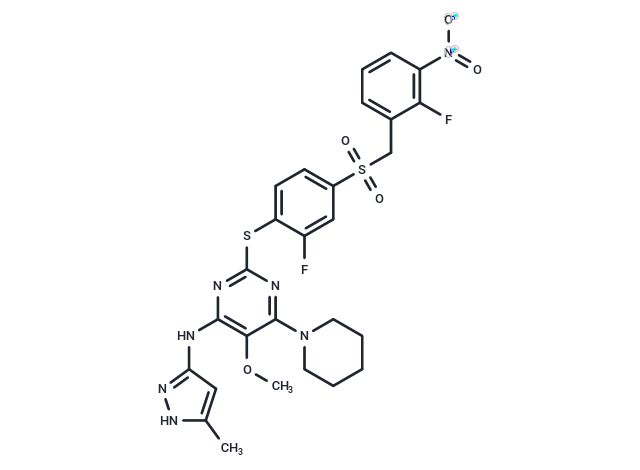Shopping Cart
- Remove All
 Your shopping cart is currently empty
Your shopping cart is currently empty

Centrinone-B (LCR-323) is a potent and highly selective PLK4 inhibitor with a Ki of 0.59 nM.

| Pack Size | Price | Availability | Quantity |
|---|---|---|---|
| 2 mg | $199 | In Stock |
| Description | Centrinone-B (LCR-323) is a potent and highly selective PLK4 inhibitor with a Ki of 0.59 nM. |
| Targets&IC50 | PLK4 (G95L):497.53 nM (Ki), Aurora A:1239 nM (Ki), Aurora B:5597.14 nM (Ki), PLK4:0.59 nM (Ki) |
| In vitro | Centrinone-B (LCR-323) is a highly potent and selective PLK4 inhibitor that can reduce centrosomes without affecting Aurora A/B, and it induces apoptosis in most melanoma cell lines[2]. |
| Alias | LCR-323, LCR323, LCR 323 |
| Molecular Weight | 631.67 |
| Formula | C27H27F2N7O5S2 |
| Cas No. | 1798871-31-4 |
| Smiles | COc1c(Nc2cc(C)[nH]n2)nc(Sc2ccc(cc2F)S(=O)(=O)Cc2cccc(c2F)[N+]([O-])=O)nc1N1CCCCC1 |
| Relative Density. | 1.54 g/cm3 (Predicted) |
| Storage | store at low temperature | Powder: -20°C for 3 years | In solvent: -80°C for 1 year | Shipping with blue ice. | |||||||||||||||||||||||||
| Solubility Information | DMSO: 20 mg/mL (31.66 mM), Sonication is recommended. H2O: < 0.1 mg/mL (insoluble) | |||||||||||||||||||||||||
Solution Preparation Table | ||||||||||||||||||||||||||
DMSO
| ||||||||||||||||||||||||||

Copyright © 2015-2025 TargetMol Chemicals Inc. All Rights Reserved.